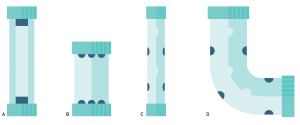Improved POU Disinfection with UVC LEDs
Published on by Naizam (Nai) Jaffer, Municipal Operations Manager (Water, Wastewater, Stormwater, Roads, & Parks) in Technology
UVC LEDs decrease the footprint for drinking water.
More than 660 million people lack access to clean drinking water. This intensifying problem due to growing population and shrinking water tables is driving innovation in drinking water disinfection systems, and the momentum is increasing as improvements in the performance of Ultraviolet C (UVC) light emitting diodes (LED) are matching the requirements of point-of-use (POU) systems.
UVC LEDs provide designers with a more effective germicidal light source; more design flexibility, which leads to more optimized systems; and reduced cost of ownership for the end user. Powerful UVC LEDs are figuring prominently into designs for everything from home and office appliances to commercial systems for water purification.
Access to the right germicidal wavelengths
In UV disinfection, light in the range of 250 to 280 nanometers (nm) disrupts the DNA of microorganisms, rendering them unable to reproduce. The action spectrum for bacteria is commonly reported as 265 to 275 nm peak wavelengths, although wavelength susceptibility may vary among a large number of bacterial and viral strains.
Traditionally, POU system designers have relied on low-pressure mercury arc lamps, which emit a discrete wavelength at 253.7 nm, to access this germicidal range. These lamps provide sufficient power for the systems and have become the industry standard.
However, UVC LEDs are emerging as an alternative light source because of their design benefits over lamps. UVC LEDs are solid-state devices with a continuous emission spectrum across a specified range. The peak wavelength of the emission may be tailored to germicidal wavelengths with new technology in crystal growth for wide band gap semiconductors such as LEDs (see Figure 1).
Figure 1 shows that the low-pressure mercury lamp emission line intersects the germicidal effectiveness curve below the peak absorption. Although this is not the optimum germicidal wavelength, sufficient emission for DNA inactivation exists. The emission of the UVC LED delivers more overlap of the most critical wavelengths for disinfection, making it a more efficient light source for these systems.
Design flexibility for flow cell size and shape
Optimum design of a water purification flow cell — the so-called UV Reactor — ensures UVC light is delivered in the most efficient and  effective manner by maximizing overall UV dosage and delivering uniform light distribution so that no target microbes escape exposure. To achieve this, system designers consider flow cell size and shape, water flow rate in the cell, and the system’s UV power.
effective manner by maximizing overall UV dosage and delivering uniform light distribution so that no target microbes escape exposure. To achieve this, system designers consider flow cell size and shape, water flow rate in the cell, and the system’s UV power.
With traditional disinfection systems, the reactor design must adapt to the shape of a mercury bulb, which is a long, cylindrical tube (Figure 2A). This shape dictates the footprint of the UV unit in the water system, limiting the system designer’s options for overall size and configuration of the reactor. Conversely, UVC LEDs are a point light source in a durable, compact package, which creates an opportunity for maximum design freedom regarding the reactor footprint (see Figure 2B, C and D). The small size of the UV source enables smaller POU disinfection systems and the flexibility to address the maximum fluence rate and field uniformity to produce ever more efficient reactors.
Additionally, in applications where space is at a premium or increased efficiency is needed, system designers can optimize the field of uniformity by leveraging reactor designs with highly reflective inner surfaces. With this design, photons experiencing multiple internal reflections are recycled to contribute to the cumulative disinfection dosage. The most common material in traditional UV reactors has been stainless steel, which only has 28 to 33 percent reflectance of UV light. Alternatives include expanded polytetrafluorethylen (PTFE), which provides more than 90 percent reflectance in the UVC range or almost three times more effectiveness than traditional reactors.
Attached link
http://www.watertechonline.com/improved-pou-disinfection-with-uvc-leds/Taxonomy
- UV Disinfection
- Technology
- Drinking Water